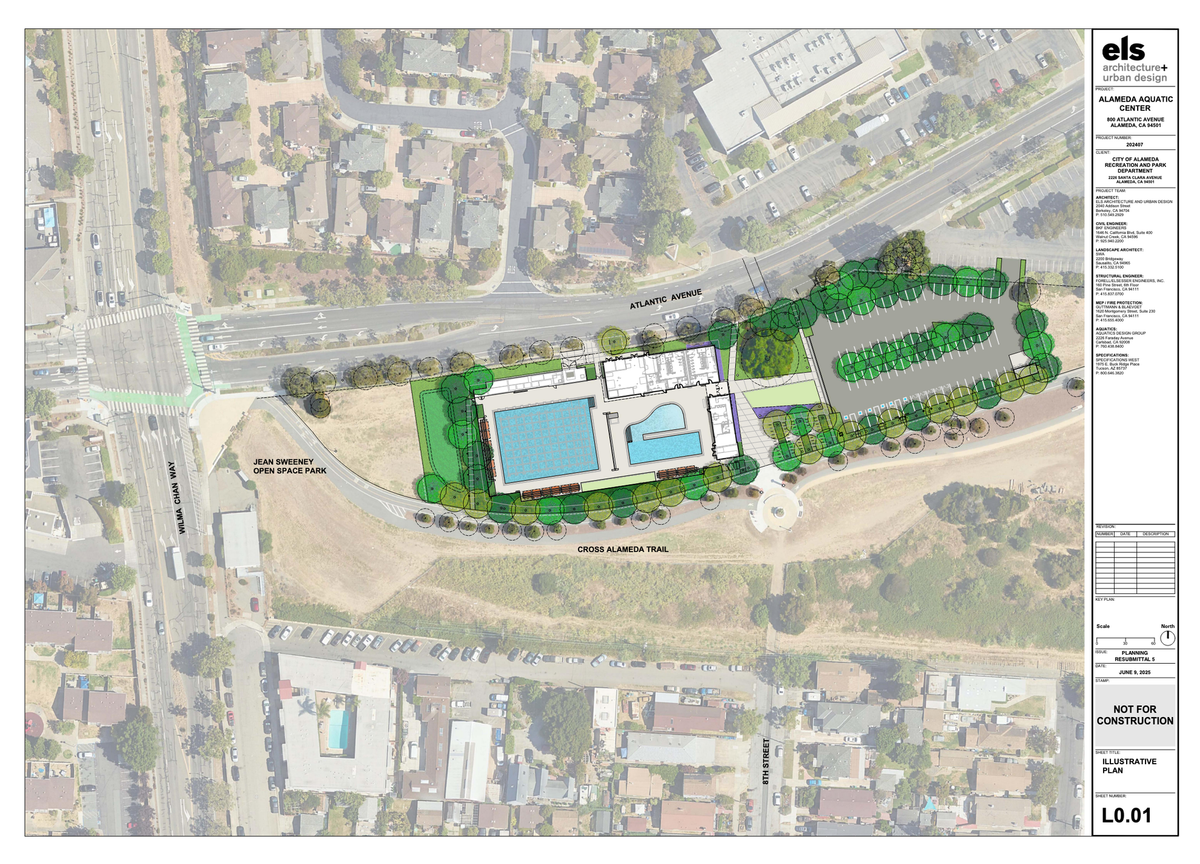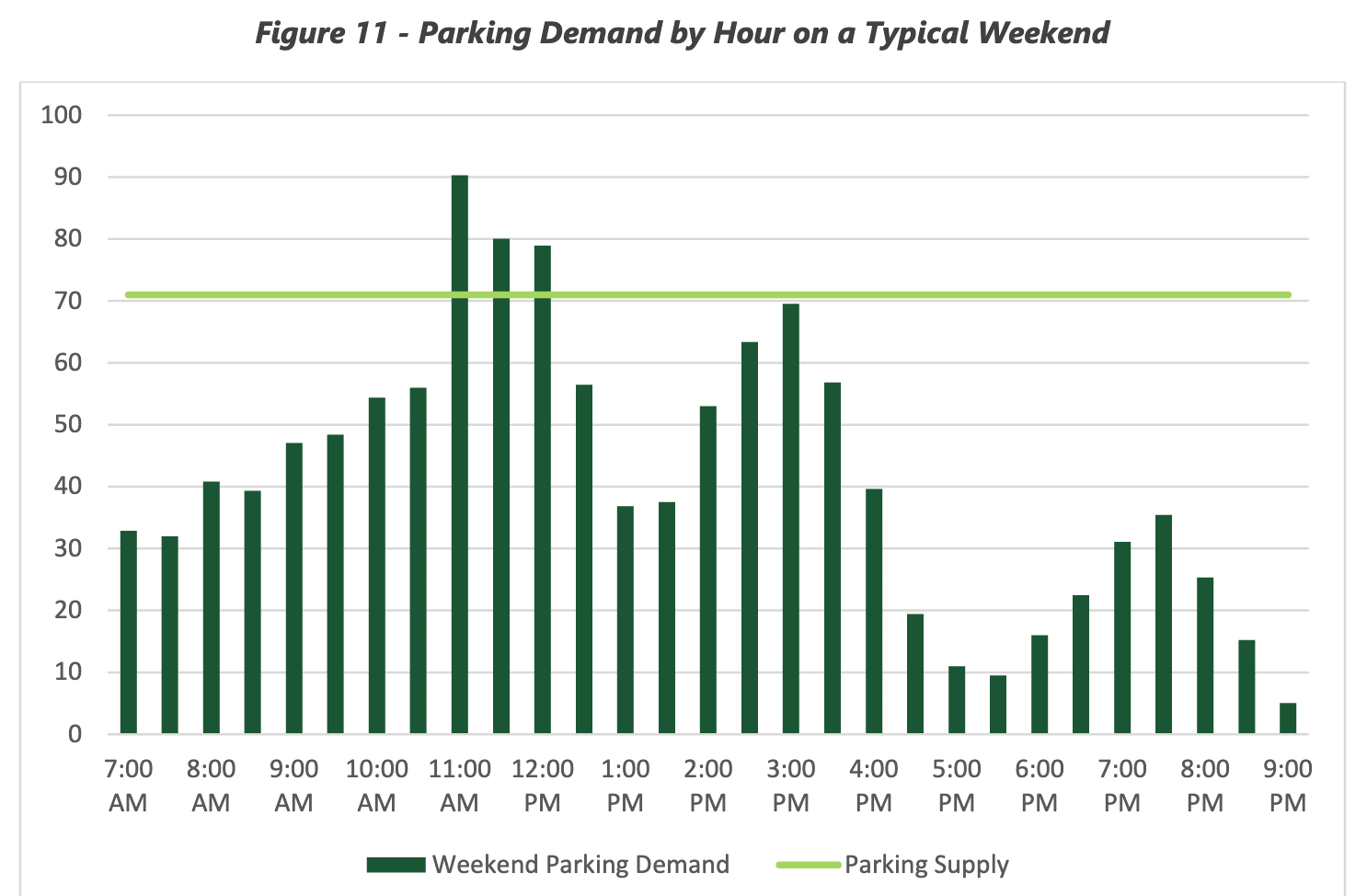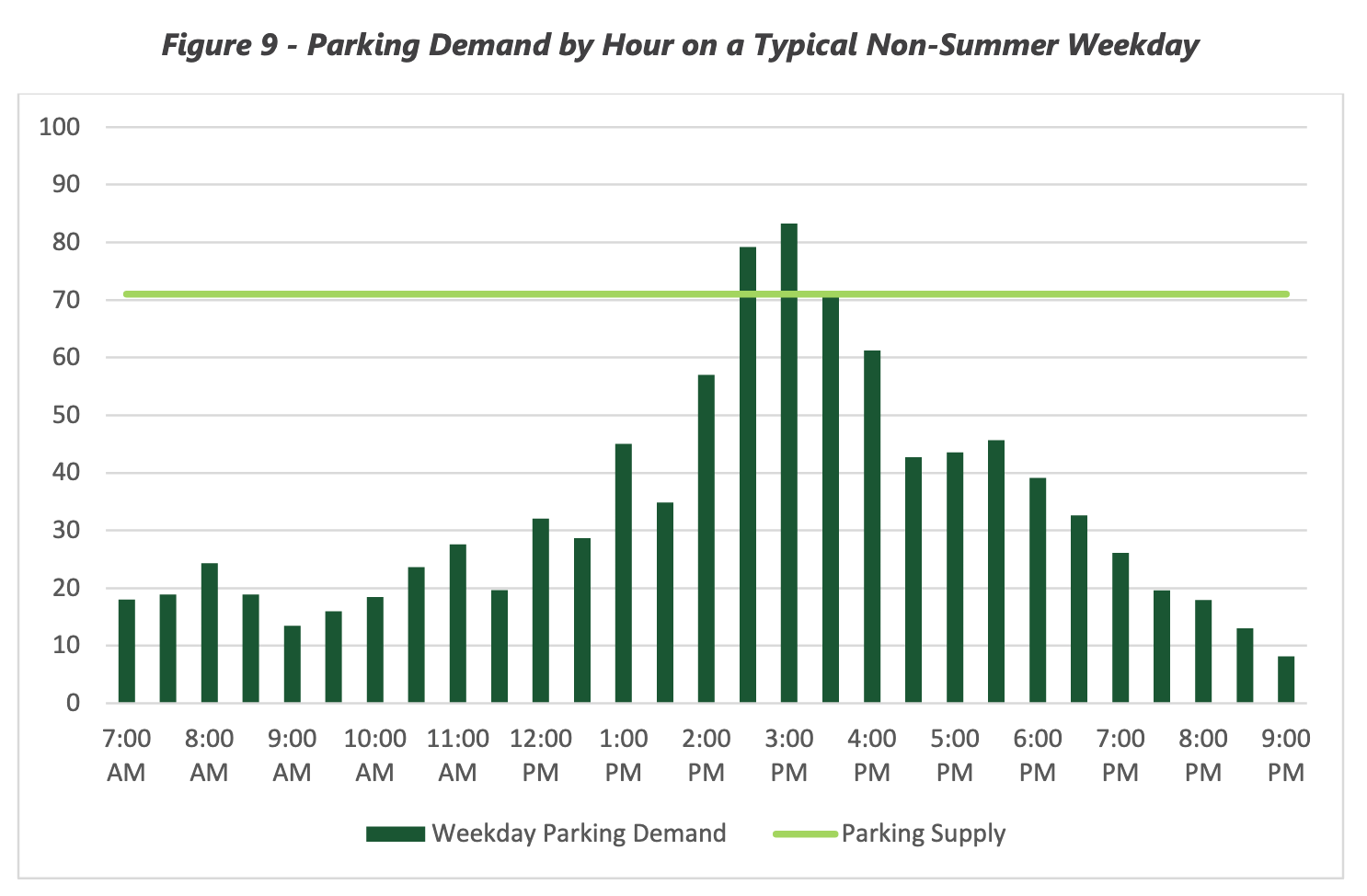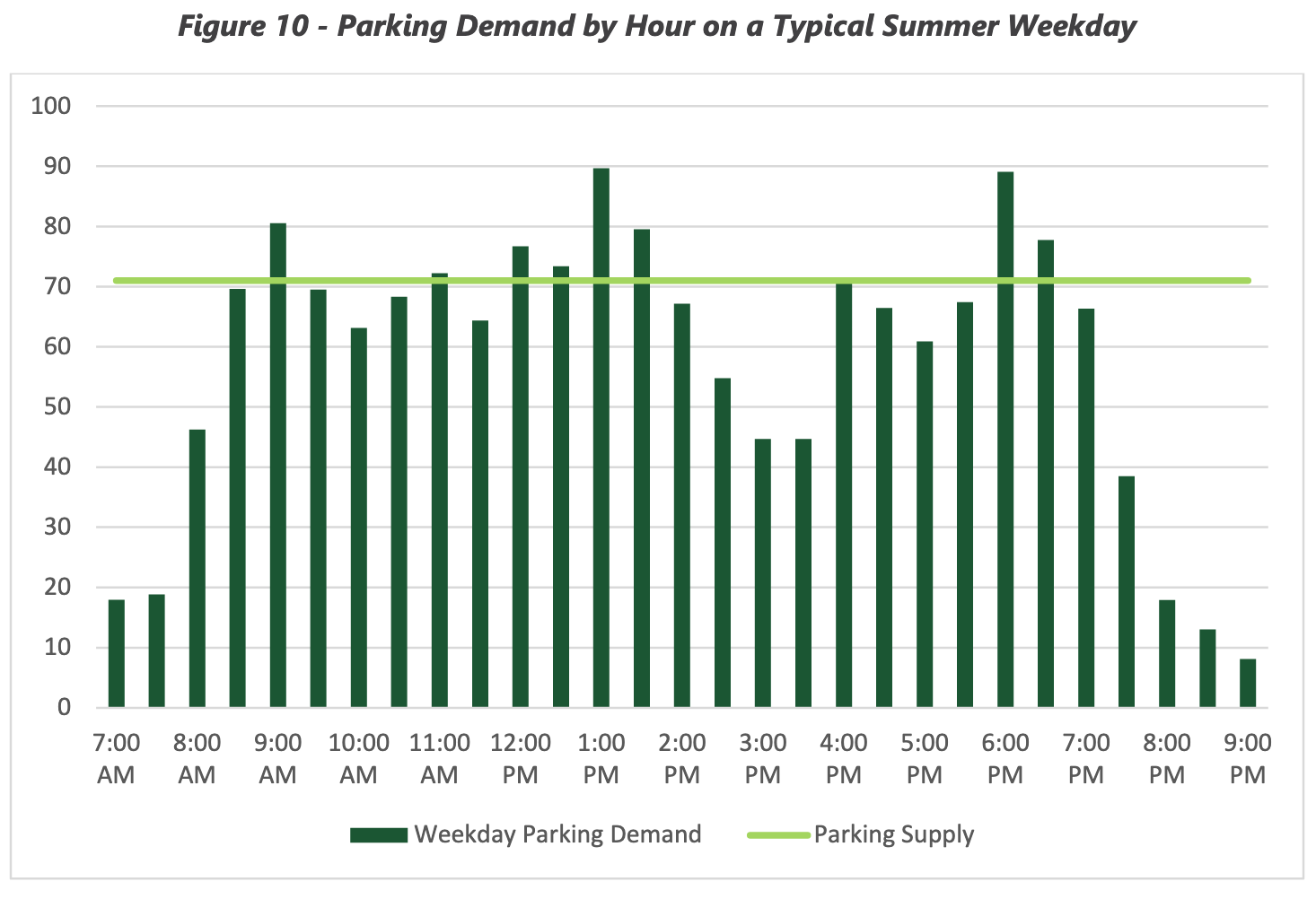The Alameda Aquatic Center will build 67 off-street parking spots... because of the pseudo-science of "parking generation"

While Piedmont can build a parking-free aquatic center, Alameda city staff feel compelled by questionable "parking generation" reports to turn half of our aquatic center's site plan into parking. And instead of viewing this parking as a potential revenue source to offset pool entry fees and a strategic complement to citywide transportation efforts, the Alameda Aquatic Center team is still intending to use the city's general funds to build 100% subsidized free parking.
At its July 1 meeting, City Council should press for improvements.
First, there were going to be 60 off-street parking spots added to the western end of Jean Sweeney Open Space Park. Then, there were going to be 93 spots. Next there were going to be 71. After Monday's Planning Board meeting, there are now going to be 67 off-street parking spots:

(That's in addition to 125 existing parking spots in the neighboring office facility that the City of Alameda is arranging with the College of Alameda to serve as "overflow" parking.)
It's strange that this number is so precise but fluctuates so arbitrarily.
What size soda do we want with our meal?
Instead of paraphrasing the exact play-by-play of last Monday's Planning Board meeting which is available for watching (and did include thoughtful remarks by Planning Board members) let's instead summarize it using an extended metaphor: parking as pop.
City of Alameda acknowledges that having excessively large amounts of soda (off-street parking) included by default with every meal (new development projects) may be tasty in the moment but has negative long-term effects (subsidizing solo driver over other modes of transport and increasing the cost of projects, particularly for new housing). Therefore, the city banned bundling soda into a meal ("parking minimums") and now requires that the Planning Board approve proposals in which a developer wants to have an extra-large amount of soda:

The Planning Board's permission to drink the largest of pop sizes, when going over designated maximums in the soda section of the Alameda Municipal Code, may also come with a diet and exercise plan (a transportation demand management, or TDM, plan).
To apply this metaphor, the permitting phase of the Alameda Aquatic Center involves Alameda Rec and Park Department standing at the restaurant's counter, trying to decide how much soda to order with its meal. No longer can ARPD just order a preset meal off the value menu including a large soda. Instead ARPD, is picking an entry, maybe a side, and an optional drink. To help justify their choices, ARPD has hired a team of soda scientists.
Yes, soda scientists. These specialists help their clients to decide how much soda to order with their meal. In this work, the soda scientists are guided by a manual. The "soda generation" manual gives precise numbers for how much soda one should order with a burger, with a cheeseburger, with a grilled cheese sandwich, with a dosa, with a falafel-filled pita, with a platter of Ethiopian injera, with an order of French onion soup, with an omakase order at a sushi bar... An omakase-style dinner may have many different sizes and lengths, so the manual includes detailed tables to suggest the appropriate amount of soda to pair with each possible amount and combination of sushi. The 5th edition of the manual required 838 pages to cover all of these possibilities.
Some of the possibilities that are not in those hundreds of pages of the soda generation manual: That soda may not pair well with every dish or every cuisine. That drinking soda with every single meal is, ultimately, unhealthy. That there are many more possible drinks that someone could potentially order at a restaurant if you invested some more energy into reading the menu, trying new things, and being willing to be disappointed by your first order and try something new the next time.
Even the president of the Institute for Soda Scientists— the publishers of this manual — wrote a column in the organization's magazine in 2019 denouncing "soda minimum" policies (the policy that City of Alameda removed from its zoning code soon after). And yet, the soda scientists are still guided in their work by the 6th generation of this manual that is based on decades of watching how much soda people drink when given a cup, open access to a soda machine for refills, and 100% free parking quietly bundled into the meal ordered by a project's developer.
A decent discussion with an arbitrary outcome
When ARPD brought reports from its on-call soda scientists to Monday’s Planning Board meeting, board members offered thoughtful remarks and asked probing questions — but with staff signaling a desire to keep the project moving forward, the contradictions went unresolved, and the result was an arbitrary and underwhelming compromise:
- When asked to compare to other public pools, a consulting architect mentioned a new aquatic center under construction by the City of Piedmont with two pools of the same size — and zero new parking spots. For City of Mountain View, a new aquatic center was recently built with some new parking but less than Alameda's planned amount. In San Francisco, another pool project is building 30 spots of parking. In the architect's words: "It's truly all over the map."
- When asked about older parks that get by with zero soda, like Rittler Park, ARPD’s director confirmed that Rittler has operated for decades without any off-street parking. But instead of treating that as a precedent (or mentioning the other ARPD parks that operate without off-street parking), the director pointed out that portions of the playing fields within Rittler Park will soon be turned into 34 new convenient, free off-street parking spots!
- Planning Board members asked targeted questions about whether that much soda was really needed year-round or just during certain hours of peak summer months. Why build 71 spots of new parking, in addition to the 125 overflow spots, when it's only necessary for targeted peaks?



The soda scientists' estimates for how many parking spots will be used by people driving to the aquatic center. Note that these assume > 90% of people driving, with ~1.1 people per car (that is, almost no carpooling), and no TDM program to incentivize other modes of transport or to de-incentivize solo auto driving. Even with those auto-centric assumptions, there are very few hours when all 71 proposed spots would be full. Under no typical conditions would more than a fraction of the already existing 125 overflow spots be utilized. Source: Transportation and Parking Memorandum
In theory, that's also the purpose of the 125 overflow spots arranged from the College of Alameda.
- Planning Board members discussed ideas for a TDM plan and heard public comments about creative ideas for incentive programs — but didn’t pursue that approach further. Staff said that since ARPD wasn’t requesting the “Super Super Big Gulp” of parking, a TDM program wasn’t required by code.
- As the PB members asked more questions about the soda consultant's reports, city staff warned that the scientists had only estimated the amount of soda needed for the aquatics center, not the community garden plots also planned nearby. If ARPD goes back to ask the soda scientists follow-up questions, the projected soda needs for the western end of Jean Sweeney Open Space Park would likely go up further from the current 71!
A few members mentioned their openness to returning to 60 parking spots, as defined in a city's plan from 2015. But when a member actually proposed modifying the motion on the table, he proposed 67. Why 67? Because that board member thought that removing four specific parking spots from the site plan would yield additional landscaping to improve the appearance as people drive into the parking lot.
All present members of the Planning Board voted for this motion — a compromise to move the project ahead without delay — but also a compromise with little grounding in the city's transportation or climate plans.
Using our senses and judgement, rather than blindly following consultant's manuals
Here's the good news: American land-use and transportation policies are no longer stuck with the auto-centric defaults of the postwar error.
Here's the bad news: We're collectively at a transition point. The old ways may no longer be mandated by zoning codes, financial lenders, or the Institute of Transportation Engineers and its ITE Parking Generation Manual. (Those are the actual names of the "soda scientists" and their manual.) However, with this new flexibility comes new responsibilities:
- Project leaders need to be more sophisticated in what they ask of their consultants — otherwise they'll default to their old ways out of habit or defensibility. The aquatic center team would ideally have hired a planner to actually write a TDM plan, rather than — or at least before — an engineer performing a parking-generation study.
- Project leaders in the public sector have an additional challenge. In the private sector, project leaders can be guided by dollars. Subsidizing free parking is a huge expense for commercial real estate, so developers are careful to analyze its actual cost-benefit tradeoffs. However, for the public sector, project leaders aren't guided as narrowly by financials. They must use judgement to assess the overall value of a parking spot, relative to their project's core amenities, and relative to its effects — beneficial and negative — on the entire community.
Ultimately, instead of pseudo science, we collectively need:
- Closer study of how Alameda’s existing parks and neighborhoods function without off-street parking. Krusi Park, Franklin Park, Rittler Park (at least for now), and Tillman Park on Bay Farm all operate successfully with only on-street parking. Rather than theoretical demand models, we should use these lived examples as baselines for what’s already working.
- Direct conversation about tradeoffs and choices. If we say we support our climate and transportation goals, then we have to make those values visible in how we allocate capital budgets and how all city departments operate. We should expect more than just the bare minimums of code from our public development projects.
- Upfront admission that we cannot precisely model future travel behavior. Instead of pretending otherwise, we should plan for flexibility, monitor outcomes, and be ready to adjust over time. TDM programs have the benefit of being straightforward to tweak, but even physical parking can be built if truly needed in the future.
Let's practice deciding that it's alright to indulge in a cup of a reasonable size of soda with some — but not all — meals.
Next steps at City Council
The Alameda Aquatic Center, with its new plan of 67 off-street parking spots, will now go to the City Council this Tuesday.
That will also be in an overall context of a request from city staff to City Council to allocate ~$5mm more from the General Fund to the project, representing an ~18% increase in the project's budget.
The causes for that budget increase are beyond the scope of this blog post (and probably involve a number of unexpected issues, as well expected trends such as inflation and rising construction costs across California). The aquatic center is a worthwhile project, and the city should stick to it by allocating additional funds.
But with additional funds should come additional questions from City Council members:
- Should City Council ask if we can be like Piedmont, build zero new parking spots, and only utilize the 125 overflow spots that College of Alameda is offering for the city's use?
- Should City Council allow general funds to be used to construct some new parking but direct ARPD to treat parking your private auto at the aquatic center the same way that ARPD treats picnic areas at every single park — as a premium amenity that requires paying a usage fee?
- Should City Council direct ARPD to have their financial consultants build parking fees into the aquatic center's cost recover model, so that modest parking fees are used to slightly subsidize swimming operations for everyone?
- Or should City Council blindly put another $5mm of general funds toward turning more of Jean Sweeney Open Space Park into yet another surface parking lot that will have no pricing to moderate use at its peak and will sit largely empty at almost all other hours of the day...